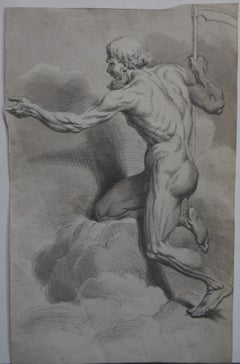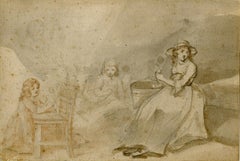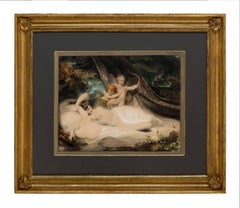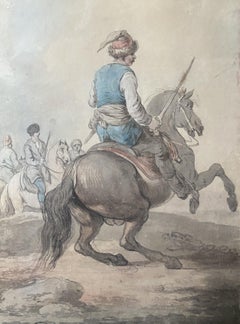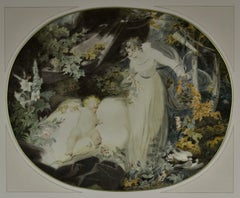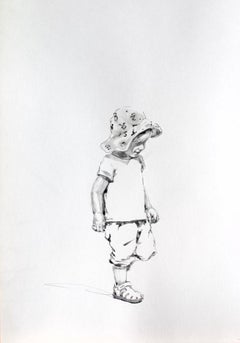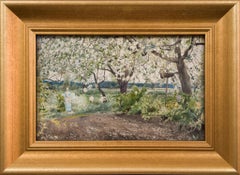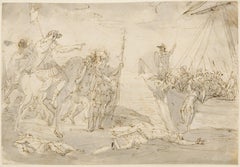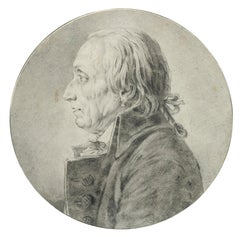1790s Figurative Drawings and Watercolors
to
1
5
Overall Width
to
Overall Height
to
242
1,511
9,976
4,029
186
267
411
633
568
812
842
940
511
376
168
1
3
2
3
2
2
1
1
1
1
1
1
3
3
2
1
1
2
1
4
4
1
Period: 1790s
French Neo classical school, Allegory of Time, original drawing
Located in Paris, FR
Neo classical school, France, end of the 18th Century
Allegory of Time,
Pen and black ink on paper, gray ink wash
30.5 x 19 cm
irregularly shaped
In g...
Category
Old Masters 1790s Figurative Drawings and Watercolors
Materials
India Ink
$574 Sale Price
30% Off
Family Group
Located in Fairlawn, OH
Family Group
Drawing in Chinese white, sepia and bistre ink, c. 1790
Signed lower left: G. Morland (see photo)
The present work appears to be a preliminary study for two Morland paintings where the artist uses portions of this preliminary study in finished exhibition paintings. The strongest association is with the painting entitled The Cottage Door (1790), now in the collection of Royal Holloway College, University of London. Morland uses the same small girl (on left side of this sheet) holding a doll on a chair in the exact same pose. The second painting entitled The Tea Garden (Tate Gallery, London, c. 1790) incorporates similar poses and gestures of the three other figure studies on this sheet.
Provenance: Colnaghi, London (Stock # D25924, see photo)
Maynard Walker Gallery, New York ( see photo of label)
Davis Galleries, New York, their Eagle stamp and stock number (see photo)
Ms. Gloria Kaplan (1930-2011) New York City
Regarding Maynard Walker:
Maynard Walker New York Times obit:
"Maynard Walker, an art dealer in New York City for nearly 40 years who was among the first to show the works of leading American regionalist painters, died of pneumonia Tuesday at St. Joseph's Hospital in Carbondale, Pa. He was 89 years old and lived in Lake Ariel, Pa.
In 1933, while working at the Ferargil Gallery in New York, Mr. Walker organized an exhibition for the Kansas City Art Institute that for the first time brought together the work of the regionalist painters Grant Wood, Thomas Hart Benton and John Steuart Curry.
After Mr. Walker opened his own gallery, at 108 East 57th Street, in 1935, these artists joined him and showed regularly there. The gallery was also among the first to show the work of George Grosz, the German painter and caricaturist, who moved to the United States in 1932. The gallery moved to 117 East 57th Street after the war."
Condition: Aging to paper
Slight fading to ink
Tiny spotting in image
All consistent with the age of the drawing
Image size: 6 3/8 x 9 1/2 inches
Frame size: 14 1/4 x 17 1/4 inches
George Morland was born in London on 26 June 1763. He was the son of Henry Robert Morland, and grandson of George Henry Morland, said by Cunningham to have been lineally descended from Sir Samuel Morland, while other biographers go so far as to say that he had only to claim the baronetcy in order to get it. Morland began to draw at the age of three years, and at the age of ten (1773) his name appears as an honorary exhibitor of sketches at the Royal Academy. He continued to exhibit at the Free Society in 1775 and 1776, and at the Society of Artists in 1777, and then again at the Royal Academy in 1778, 1779 and 1780.
His talents were carefully cultivated by his father, who was accused of stimulating them unduly with a view to his own profit, shutting the child up in a garret to make drawings from pictures and casts for which he found a ready sale. The boy, on the other hand, is said to have soon found a way to make money for himself by hiding some of his drawings, and lowering them at nightfall out of his window to young accomplices, with whom he used to spend the proceeds in frolic and self-indulgence. It has been also asserted that his father, discovering this trick, tried to conciliate him by indulgence, humouring his whims and encouraging his low tastes.
He was set by his father to copy pictures of all kinds, but especially of the Dutch and Flemish masters. Among others he copied Fuseli's Nightmare and Reynolds's Garrick between Tragedy and Comedy. He was also introduced to Sir Joshua Reynolds, and obtained permission to copy his pictures, and all accounts agree that before he was seventeen he had obtained considerable reputation not only with his friends and the dealers, but among artists of repute. A convincing proof of the skill in original composition which he had then attained is the fine engraving.
It is said that before his apprenticeship to his father came to an end, in 1784, Romney offered to take him into his own house, with a salary of £300, on condition of his signing articles for three years. But Morland, we are told, had had enough of restraint, and after a rupture with his father he set up on his own account in 1784 or 1785 at the house of a picture dealer, and commenced that life which, in its combination of hard work and hard drinking, is almost without a parallel.
Morland soon became the mere slave of the dealer with whom he lived. His boon companions were "ostlers, potboys, horse jockeys, moneylenders, pawnbrokers, punks, and pugilists." In this company the handsome young artist swaggered, dressed in a green coat, with large yellow buttons, leather breeches, and top boots. "He was in the very extreme of foppish puppeyism", says Hassell; "his head, when ornamented according to his own taste, resembled a snowball, after the model of Tippey Bob, of dramatic memory, to which was attached a short, thick tail, not unlike a painter's brush." His youth and strong constitution enabled him to recover rapidly from his excesses, and he not only employed the intervals in painting, but at this time, or shortly afterwards, taught himself to play the violin. He made also an effort, and a successful one, to free himself from his task-master, and escaped to Margate, where he painted miniatures for a while. In 1785 he paid a short visit to France, whither his fame had preceded him, and where he had no lack of commissions.
Returning to London, he lodged in a house at Kensal Green, on the road to Harrow, near William Ward, intercourse with whose family seems for a time to have had a steadying influence. It resulted in his marriage with Miss Anne Ward...
Category
English School 1790s Figurative Drawings and Watercolors
Materials
Ink
Venus
Located in London, GB
Richard Westall, R.A. (1765-1836)
Venus
signed and dated ‘R. Westall 1794’ (lower right)
pencil and watercolour, with white heightening
image 11 ⅞ x 15 ¼ in. (30.2 x 38.7 cm.)
frame 22 ⅛ x 26 in. (56.3 x 66.1 cm.)
Provenance:
Private Collection, UK.
Venus (1794) was produced during a highly creative and defining period of Richard Westall’s career and artistic development, when from 1790-95 the ambitious young artist was sharing a house at 57 Greek Street, Soho, with his friend Sir Thomas Lawrence, the future President of the Royal Academy.
Whilst lodging together, Lawrence became an Associate of the Royal Academy in 1791, Westall the following year, and both were elected full-members in 1794 – the year Lawrence was appointed Painter-in-Ordinary to His Majesty King George III. Westall was to become Queen Victoria’s first Drawing Master, before her ascension to the throne.
It was in this very year, 1794 - as the two young artists became Royal Academicians - that the present watercolour was executed, and it is exciting to speculate that Lawrence would have examined and given his thoughts on the work.
Highly comparable to The Wallace Collection’s Nymph and cupids (c.1793, cat. P757), acquired by Francis Seymour-Conway (1777-1842), 3rd Marquess of Hertford, (who hung it in his bedroom), the mid-1790s saw Westall exhibiting and returning to similar subject-matter on a number of occasions. Two works with titles that could be applied to the present picture were exhibited at the Royal Academy, in 1794 (no. 341 Nymph and Cupids) and 1795 (no. 620, A Wood–nymph and Cupids). However, a print after the watercolour, engraved by F. Screen, entitles the piece Venus.
Westall is regarded as a great virtuoso watercolourist, and Venus is evidence of the young artist’s mastery of the medium. Indeed, it is unusual to find a watercolour of comparable age so well preserved, and retaining such vibrancy - the superb condition providing an insight into his exceptional brushwork and use of colour.
Venus languishes luxuriously on her woodland bed, the trunk of a tree resembling a curtain, while three winged putti play beside her, seeming to gesture to someone in the woods. Cupid draws back his bow and aims an arrow of love, perhaps about to pierce the heart of a hunting nobleman, or unsuspecting woodcutter. The striking contrast between the almost luminescent nymph, with the deep, rich, luxuriant forest, gives the glade an alluring sense of mystery – perhaps an allusion to the mysteries of the heart, a pre-occupation with Romanticism, central to the emerging thought of the time. Westall can be classified as one of the great Romantic artists, and even painted Lord Byron’s portrait...
Category
Romantic 1790s Figurative Drawings and Watercolors
Materials
Watercolor, Pencil
$25,526
Attributed to Francesco Casanova (1727-1803), A Mamluk fighting , watercolor
Located in Paris, FR
Attributed to Francesco Casanova (1727-1803),
A Mamluk fighting on his horse,
watercolor and ink on paper
35 x 26 cm
Framed 54 x 44 cm (vintage frame, the mount and the back have b...
Category
1790s Figurative Drawings and Watercolors
Materials
Watercolor
Cupid Sleeping - 18th Century British watercolour by Richard Westall RA
Located in London, GB
RICHARD WESTALL, RA
(1765-1836)
Cupid Sleeping; from a poem of Mrs Robinson
- The Duchess of Devonshire Discovers the Sleeping Cupid
Watercolour on paper, oval
36 by 44.5 cm., 14 ¼ by 18 in.
(frame size 55 by 66 cm., 21 ¾ by 26 in.)
Exhibited:
London, Royal Academy, 1792, no.448.
Richard Westall was bon in Reepham, near Norwich. Initially apprenticed to a London silver engraving he began studying at the Royal Academy Schools from 1785 and exhibited regularly at the Royal Academy between 1784 and 1836. Westall became an Associate member of the Royal Academy in 1792 and a full member in 1794.
Westall painted in both oil and watercolour, his works being romantic and neoclassical in style. He contributing to both Boydell’s Shakespeare Gallery and Fuseli’s Milton Gallery and was also a prolific book illustrator of both fiction and poetry including works by Sir Walter Scott and Byron, whose portrait he also painted. For a time he was also art master to the young Princess Victoria.
This is probably Westall’s 1792 Royal Academy exhibit (no.448). The subject was inspired by the poem Cupid Sleeping by the poetess-actress Mary Darby Robinson, which had been published in the previous year. The poem was dedicated to Georgiana, Duchess of Devonshire and the picture show the Duchess discovering the sleeping cupid who she then relieves of his bow and arrows. Mrs Robinson was not only the Duchess’s protégée but also the first public mistress of the Prince of Wales. William Nutter’s engraving of Westall’s picture was also dedicated to the Duchess of Devonshire.
Close in a woodbine's tangled shade,
The blooming god asleep was laid;
His brows with mossy roses crown'd;
His golden darts lay scatter'd round;
To shade his auburn, curled head,
A purple canopy was spread,
Which gently with the breezes play'd,
And shed around a soften'd shade.
Upon his downy smiling cheek,
Adorned with many a "dimple sleek,"
Beam'd glowing health and tender blisses,
His coral lip...
Category
Realist 1790s Figurative Drawings and Watercolors
Materials
Watercolor
Related Items
On the walk
Located in Oslo, NO
A minimalist but masterfully executed monochrome watercolor. The work is striking in its lightness - although there is nothing on it except the figure of a child, from the way he is ...
Category
Realist 1790s Figurative Drawings and Watercolors
Materials
Paper, Watercolor, Pencil
Watercolor The Garden at Sickelsjö, 1883
Located in Stockholm, SE
We are delighted to present a stunning watercolor by the Swedish artist Albert Theodor Gellerstedt. This artwork, titled "Sickelsjö Trädgård" was created on June 8, 1883. The paintin...
Category
Romantic 1790s Figurative Drawings and Watercolors
Materials
Paper, Watercolor
English School, circa 1800 Georgian watercolor, The Sailor's return
Located in Harkstead, GB
A delightful rustic scene dating to circa 1800 with the sailor returning to his thankful wife and the domestic idyll of his country cottage. The harbour with sailing ships ferrying c...
Category
Romantic 1790s Figurative Drawings and Watercolors
Materials
Watercolor, Laid Paper
$265 Sale Price
30% Off
H 6.5 in W 8.5 in D 1 in
France 19th century, The Bohème artist in his workshop, watercolor
Located in Paris, FR
France circa 1850
The Bohème artist in his workshop
Watercolor on paper
15.5 x 21.5 cm
In good condition except a small tear (visible on the photographs) on the upper right border.
I...
Category
Romantic 1790s Figurative Drawings and Watercolors
Materials
Watercolor
$689 Sale Price
20% Off
H 6.11 in W 8.47 in
Early 20th Century Country Cottage Landscape with Ducks
Located in Soquel, CA
Serene depiction of a country house with ducks milling around in the grass by Josh Fisher (British, 1859-1930). Signed "JOSH FISHER" in the lower-left corne...
Category
Realist 1790s Figurative Drawings and Watercolors
Materials
Paper, Watercolor
$920 Sale Price
20% Off
H 20 in W 26 in D 1 in
Duchándome en Cuerpo Ajeno. Nude watercolor on paper
Located in Miami Beach, FL
Throughout his artistic career, Castro has exalted the figure and genitality of the Latin American man, putting into tension the limits imposed by the sex/gender system that are part of an unquestionable patriarchal and phallocentric order. The majority of those portrayed are inhabitants of the Colombian coast, also constructing alternative ways of conceiving Latin American identity. By breaking taboos about corporality and male sexuality, his work has been censored on numerous occasions due to public accusations of immorality and pornography. Celso Castro’s work is a bare-bulb erotic photo...
Category
Contemporary 1790s Figurative Drawings and Watercolors
Materials
Watercolor, Paper, Ink
$500
H 19.5 in W 13.75 in D 0.1 in
Gipsies with Horses in England Landscape Painting by 19th Century British Artist
Located in Preston, GB
Gipsies with Horses & Covered Wagons in the Wild Moorland Landscape of England. An Original Watercolour Painting by 19th Century British Artist, James Walter Gozzard...
Category
Realist 1790s Figurative Drawings and Watercolors
Materials
Board, Paint, Watercolor
$1,760 Sale Price
20% Off
H 10 in W 12 in D 1 in
1937 Academic Female Nude Charcoal Drawing "Head in Hand" UC Berkeley
By John Ayres
Located in Arp, TX
John Ayres
Head in Hand
May 1, 1937
Charcoal on Paper
25"x19", unframed $1250
Signed and dated in charcoal top right
*Custom framing available for additional charge. Please expect fr...
Category
Realist 1790s Figurative Drawings and Watercolors
Materials
Paper, Charcoal, India Ink
George H Hay, Spinning Wool, Watercolour
Located in Cheltenham, GB
This late 19th-century watercolour by Scottish artist George H Hay RSA (1831-1912) depicts four young ladies, wearing outfits synonymous with the 1820s, spinning wool within a simple...
Category
Romantic 1790s Figurative Drawings and Watercolors
Materials
Watercolor, Paper
French School 19th Century, Portrait of a dandy, watercolor on paper
Located in Paris, FR
French School 19th Century,
Portrait of a dandy,
watercolor on paper
19 x 13 cm
Signed (?) with pencil lower right "L ... " illegible
Framed : 29 x 23 cm
Category
Romantic 1790s Figurative Drawings and Watercolors
Materials
Watercolor
$276 Sale Price
30% Off
H 7.49 in W 5.12 in
French School, Academic Study (Male Nude)
Located in London, GB
Charcoal on paper, 60cm x 42cm, (74cm x 60cm framed). The picture is framed behind museum quality non-reflective UV glass.
Drawings and paintings of the nude were central to academ...
Category
Old Masters 1790s Figurative Drawings and Watercolors
Materials
Paper, Carbon Pencil
A heron fishing – Edo School, 19th century
Located in Middletown, NY
Ink and watercolor on fibrous Japon paper laid down to period cream laid paper, 6 x 7 1/2 inches (155 x 190 mm). Minor toning and some insect damage on the mount, painting itself rem...
Category
Edo 1790s Figurative Drawings and Watercolors
Materials
Ink, Watercolor, Handmade Paper, Laid Paper
Previously Available Items
Caesar's landing in Brittany, an original drawing by Giuseppe Bernardino Bison
By Giuseppe Bernardino Bison
Located in PARIS, FR
We wish to thank Mrs. Bożena Anna Kowalczyk who suggested this drawing be attributed to Giuseppe Bernardino Bison during a direct examination of the artwork.
This drawing, perfectly representative of Giuseppe Bison's technique, represents an episode in Caesar's life that may have been inspired by his incursions on the Brittany coast. It is presented in an exceptional 18th...
Category
Old Masters 1790s Figurative Drawings and Watercolors
Materials
Ink
Portrait of an Revolutionary - Drawing from the School of Jacques-Louis David
By Jacques-Louis David
Located in PARIS, FR
This psychologically analytic drawing is a portrait of a disillusioned middle-aged man. Probably drawn around 1793-1795, it is an illustration of the immense graphic talent of David'...
Category
French School 1790s Figurative Drawings and Watercolors
Materials
Chalk
France 18th Century, A Lady in red, pastel
Located in Paris, FR
France, end of the 18th century
Portrait of a lady in a red coat
Pastel on paper
27 x 22 cm
In good condition
Framed 37 x 33 cm (a small lack in the gilding lower right, see photo p...
Category
Old Masters 1790s Figurative Drawings and Watercolors
Materials
Pastel
Hommage à la Fontaine, 18th Century, Academic, French School, Figurative drawing
Located in Paris, FR
18th century French School
"Hommage à Jean de La Fontaine" (Tribute to Jean de La Fontaine)
Pen and brown ink and grey wash on paper
11 x 7.5 cm
Fr...
Category
Academic 1790s Figurative Drawings and Watercolors
Materials
Ink
